#ph history
Text


[...]


Some People Need Killing: A Memoir of Murder in My Country, Patricia Evangelista
#ph history#this book is actually about the drug war but i need to get a good tag for that one. which i will figure out. in a minute#ph literature#book club tag#colonial era ph
38 notes
·
View notes
Text
GOMBURZA (2023) - MMFF REVIEW

“Vivan Los Filipinos. Mabuhay ang mga Filipino.”
This film is the story of the three martyr priests. Three Filipinos who were part of the native community who were once under Spanish colonial rule and oppression. If you have been updated, or have been listening in your elementary Philippine history classes, it’s GOMBURZA, not MAJOHA.
Despite it being produced by Jesuit Communications, the film was able to execute (No pun intended) a factual depiction on a turning point of Philippine history without overused emphasis of religion. It was able to capture how the Catholic faith was used as an instrument of oppression during the Spanish colonial period (This was especially ironic considering how return of the religious orders, including the Jesuits, were the reason for the silencing of the secularization movement). What also impressed me is that almost every single detail in the movie, even in the dialogue, came from actual events in history. It is evident that enough research was made to make this film as accurate as possible.
The film’s cinematography was able to capture life during the period whether it was amongst the Filipino liberals, the Spanish priests, the Governor-Generals, or even the three main characters in our story. With every other scenes of the film shifting from light to dark atmospheres, this symbolized the reality of Spanish colonization — warmth, acceptance, and friendship amongst fellow Filipinos; and ruthlessness, inhumanity, and oppression from the Spaniards (and even traitors). Adding emphasis to GomBurZa’s (2023) cinematography is its sound design. Just by feeling the cinema floor rumbling and the deeply-voiced voiceover in the film’s ending segment, this film can come to a point where it deserves its own IMAX screening.
Dante Rivero and Cedrick Juan showcase over-the-top stellar performances as Padre Mariano Gomez (played by Rivero) and Padre Jose Burgos (played by Juan). Both actors have embodied their roles, not only due to the fact that they, especially Juan, share a slight resemblance with the real life Mariano Gomez and Jose Burgos. It is also because that they were able to portray their emotions from having a friendly conversation, to later condemning their unfair arrest, trial, and death.
Pepe Diokno's time and effort in conducting research and including every important detail in the production is evident in the whole film itself, as it was not only ACTUALLY based on true events, but was able to evoke emotion and outrage, just like how the Filipinos of the 1870s did at the time.
With all of this said, GomBurZa (2023) is not only a history lesson, but also an immersion into the Spanish colonial rule and the lives of the three priests. Being a history nerd and a cinephile who has since learned the names of the three martyr priests as a little girl in elementary, I can definitely say that this was one of the only film experiences where I had witnessed the breaking of the fourth wall. The whole time I was in the cinema, it felt like I was part of their conversation, like I was a witness to their lives and execution.
What also added to this experience was that I watched the film on Rizal Day, and what better way to commemorate our national hero's contribution to Philippine independence than to learn about where it all started? Like what I always preached to my family:
Without GomBurZa, there will be no Jose Rizal. Without Jose Rizal, there would be no Andres Bonifacio. Without all of them, the Philippines and the Filipino would not exist.
GomBurZa (2023) is a cathartic experience that is definitely for the family. This film is a testament to the importance of appreciating and learning our history. Hopefully it serves as a reminder of our collective past, national identity, and the importance of our freedom.
[Metro Manila Film Festival 2023]
(my film review of "GomBurZa" is also available on letterboxd!)
#movies#writeblr#writing#creative nonfiction#creative writing#nonfiction#ph history#philippine history#period drama#historical drama#film review#film#films#movie#filipino cinema#mmff#mmff2023#mmff 2023#Cedrick juan#enchong dee#Dante rivero#philippines#movie review#gomburza#mariano gomez#Jose burgos#jacinto zamora
34 notes
·
View notes
Text
Today marks the 51st anniversary of the enactment of US-backed Martial Law in the Philippines by the late president/dictator Ferdinand Marcos Sr. One of the darkest days in the history of the country and spanning for about a decade, many human rights violations, killings, tortures, enforced disappearances, military and police abuse of power, economic downfall, environmental damages, famine, media blackout (except for those approved of the regime), and overall corruption. All for the so called "fight against communist insurgency." The Marcos family and their allies basically lived like royalites while the Filipino people suffered.
Ferdinand Emmanuel Edralin Marcos Sr. served as the 10th president of the Philippines for 20 years from 1965 to 1986. He ruled under martial law for nine years from 1972 until 1981 but kept most of his martial law powers until he was deposed in 1986. Under his regime, violence was used to enforce civil control over the citizens of the Philippines, resulting in thousands of documented cases of human rights violations.
But many people to this day continue to refer to this time as the "Golden Age" of the country, that life was good for "law abiding citizens." Here are some numbers that debunks this popular myth.
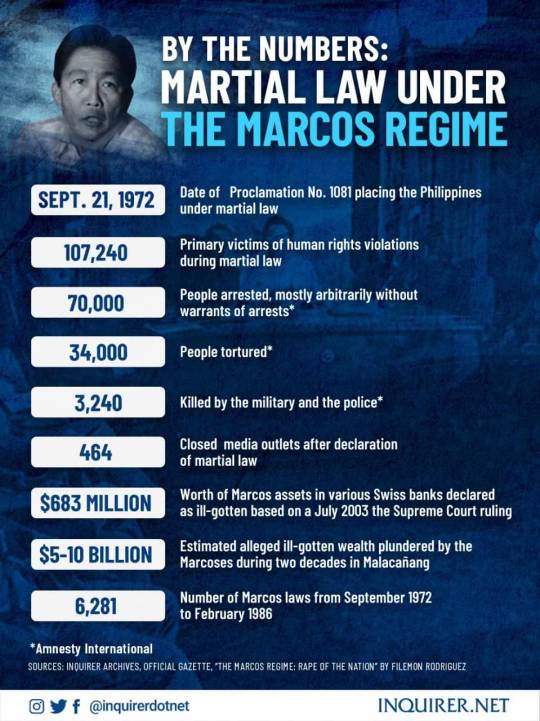
Data from the image:
Sept. 21, 1972: Date of Proclamation No. 1081 placing the Philippines under martial law.
49: Persons from the Greater Manila Area immediately arrested on Sept. 22, 1972, by the military, among them three senators, three congressmen, two provincial governors, four delegates to the Constitutional Convention and eight newsmen. First on the list was opposition senator and main political rival Benigno “Ninoy” Aquino Jr.
Sept. 23, 1972: Press Secretary Francisco Tatad announces the imposition of martial law and reads the Marcos proclamation in a nationwide televised broadcast. Marcos himself went on air at 7 p.m. to formally announce the proclamation
12-4 a.m. – Curfew was put in place
Jan. 17, 1981: Marcos signs Proclamation No. 2045 lifting the implementation of martial law ahead of the first papal visit of Pope John Paul II in February.
107,240: Primary victims of human rights violations during martial law
70,000 people arrested, mostly arbitrarily without warrants of arrests*
34,000 people tortured*
3,240 killed by the military and the police*
*Amnesty International
464: Closed media outlets after declaration of martial law
$683 million: Worth of Marcos assets in various Swiss banks declared as ill-gotten based on a July 2003 the Supreme Court ruling
$5-10 billion: Estimated alleged ill-gotten wealth plundered by the Marcoses during two decades in Malacañang
6,281: Number of Marcos laws from September 1972 to February 1986
2,036 presidential decrees
61 general orders
1,093 executive orders
1,409 proclamations and other issuances
1,525 letters of instructions
157 letters of implementation

Info from image:
Military Power
By the time martial law was in effect, the Philippine Army had an estimated strength of 17,600; the Philippine Navy with 8,000; Philippine Air Force with 9,000; and the Philippine Constabulary with 25,500.
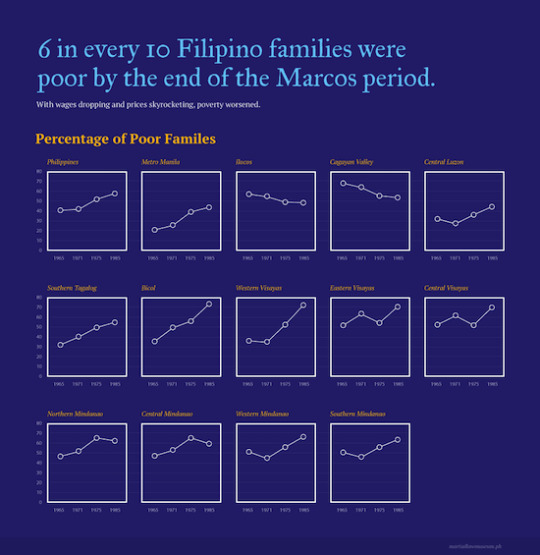
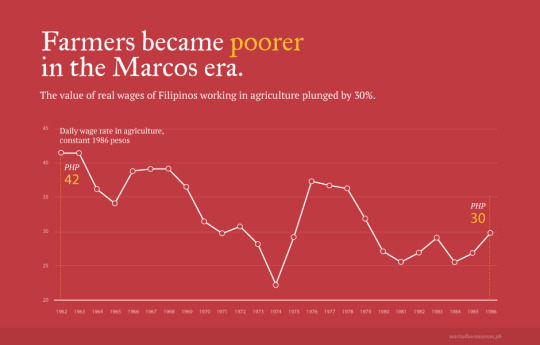

Info from images:
Poverty
Poverty worsened over the course of the Marcos era. Whereas about 4 out of 10 families were poor before Marcos took office, 6 out of 10 families were poor by the end of his rule.
Moreover, as the graph on the left shows, this is a consistent trend across the different regions of the nation, with some regions reaching as high a rate as 7 out of 10 families below the poverty line. Only two regions saw a marginal decrease in the number of poor families: the Ilocos Region and Cagayan Valley.
Daily wages of Filipino agricultural workers declined by about 30%, such that if a farmer earned Php 42 per day in 1972, he would only be earning about Php 30 in 1986. The wages of farmers even went as low as nearly half of the pre-Marcos values in 1974, right after the declaration of Martial Law (middle graph).
On the other hand, for skilled and unskilled workers in urban areas, the graph on the right shows the change in their wages from pre-Marcos to EDSA values. Skilled workers are workers with some special knowledge or skill, often having gone to college or technical school; unskilled workers are workers without this level of training.
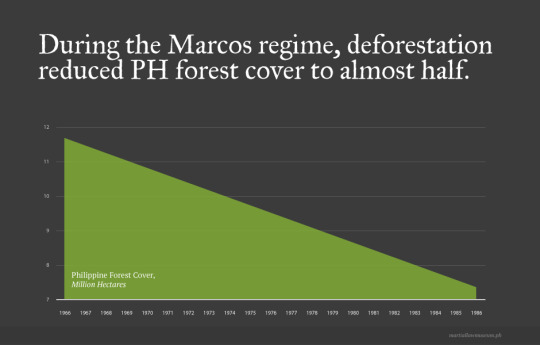
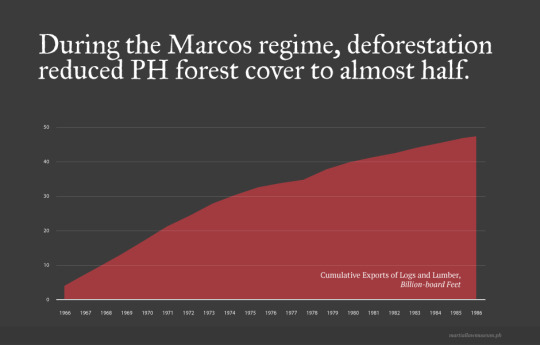
Info for images:
Deforestation
In addition to factors relating to the domestic economy, another way of assessing the Marcos regime is through its impacts on the nation’s natural resources and the environment. The graph specifically gives us an idea about how Marcos’s policies affected the country’s forest cover over the course of about 20 years.
Supposedly, about 90% of the Philippines’ 18.7 million hectares of uplands, including more than 11 million hectares officially classified as timberlands, is publicly owned. In practice, fewer than 200 individuals controlled a large fraction of the country’s forests.
In pursuit of economic gains, Marcos and his cronies’ uncontrolled exportation of timber led to a drastic reduction in forest cover. This cascades into dire environmental impacts including flooding, landslides, and even the worldwide phenomenon of global warming.
I could add more to this post, but that would be way too long.
To this day, the Marcos family, their allies, and supporters, paid or not, continue to deny these facts and claim that the Marcos family were good for the Filipino people and the country.
We must continue to remind the people of this dark time in the history, to not let history be erased and be replaced with lies, to remember the sacrifices made by the victims of Martial Law and their families, and to not let history repeat itself.
Never Forget!
Never Again!
sources:
https://philstarlife.com/news-and-views/649814-martial-law-by-the-numbers?page=6
https://martiallawmuseum.ph/magaral/martial-law-in-data/
https://newsinfo.inquirer.net/1167808/fast-facts-the-marcos-martial-law-regime
The Martial Law Museum and the Bantayog ng mga Bayani sites are good places to start reading more about this.
#Feel free to add more to this post bc i know theres way more#martial law#martial law anniversary#marcos#ferdinand marcos sr#philippines#philippine politics#bbm#bongbong marcos#ph politics#ph#ph history#history#politics#human rights#environment#historical revisionism#revisionism
23 notes
·
View notes
Text
The culmination of the bloodless revolt on February 25, 1986, kicked dictator Ferdinand E. Marcos out of Malacañang after an iron-fist rule that lasted more than a decade. His family soon went on exile in Hawaii, an experience that his son Marcos Jr. described as among the darkest days of their lives.
A decades-long project to rehabilitate their family’s image ultimately led to the Marcoses returning to power, capped by Marcos Jr.’s ascent to the presidency in 2022.
For 2024, the Palace downplayed its removal of the EDSA Revolution anniversary from the list of holidays, saying there would be “minimal socio-economic impact in declaring this day as a special non-working holiday since it coincides with the rest day for most workers and laborers.”
This year, democracy advocates are also using the EDSA revolution anniversary commemoration to amplify their opposition to charter change.
The present Constitution was completed months after the 1986 uprising, and ratified through a nationwide plebiscite in February 1987.
It replaced the 1973 Constitution, which helped Marcos justify his prolonged stay in office.
2024 Feb. 13
#philippines#edsa people power revolution#ph history#no to charter change#bbm administration#marcos era
7 notes
·
View notes
Text










“...kinandili at minahal ko pa naman...”
The First President and the Sublime Paralytic — Emilio Aguinaldo and Apolinario Mabini
#ph history#apolinario mabini#emilio aguinaldo#web weaving#heneral luna(2015)#i am having a ✨brainrot✨#Y'ALL SHOULD WATCH IT BTW IT'S ON NETFLIX AND YT WITH ENG SUBTITLES#anyways these two are side characters in that film but oh boy my monkey brain decided to hyperfixate on them#ah yes divorce arcs#my favorite /lh#rough translation of the quote: ‘...the one I cherished and loved...’#<-emilio to pole#should i tag the ship? fuck it i'm tagging the ship#mabinaldo#god bless my soul#my hamilton phase but worse#heneral luna#kinandili't minahal#zan's webs
56 notes
·
View notes
Text
I've always wanted to combine my love for language of flowers & my wish to make filipina heroes merch, so here we are. It was originally just four but I wanted the add the others I've planned eventually.

Filipina heroes as follows(start upper left)
1. Teresa Magbanua - daisy
2. Gregoria de Jesus -red rose
3. Urduja(new)- mimosa
4. Melchora Aquino - peonies
5. Gabriela Silang - gladiolus
6. Maria Clara(new) - tulips
#artph#art#artwork#jtdrawsalot#painting#jtdrawsalotart#filipinoartist#artsy#jtdrawsalotmerch#ph history#maria clara#teresa magbanua#oryang#henlu#heneral moon#heneral goon#melchora aquino#urduja#gabriela silang
17 notes
·
View notes
Text
idk how to spread this but i went on a nicanor abelardo binge which brought me to felipe de leon, who wrote Bagong Lipunan, aka the propaganda song used by M*rcos then during ML era and diktajunior during his presidential campaign. read up on why and how the composer came to write this piece after writing against japanese oppression in WW2. its important and nefarious history.
#i have to be happy he was forced to write it#this is the paradox that fascism forces#one must be glad that it was force that contributed to the creation of an oppressive tool#and not willingness#ph history#philippine history#martial law#philippine classical music
3 notes
·
View notes
Text
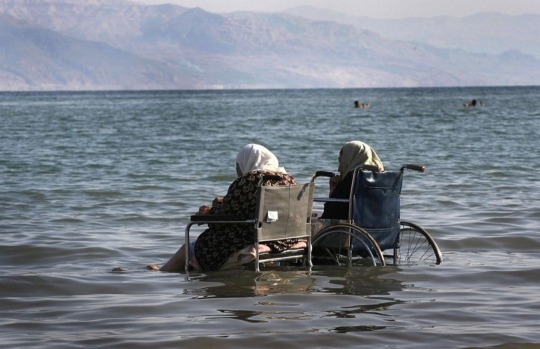
Elderly Palestinian women sit in wheelchairs as they enjoy the waters of the northern part of the Dead Sea in West Bank, Palestine. Photographed by Menahem Kahana, 2008.
#menahem kahana#palestine#palestinian history#west bank#dead sea#street photography#portrait photography#ph#from the river to the sea palestine will be free
9K notes
·
View notes
Photo

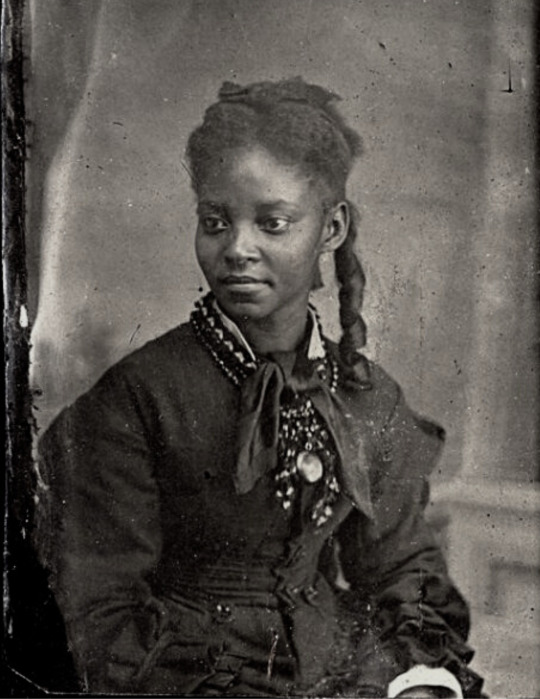






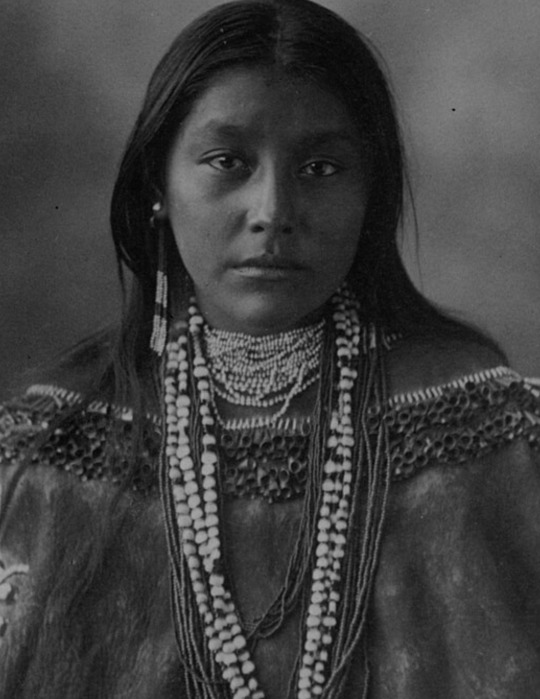

edwardian & victorian era women
#history#victorian era#vintage photography#women in history#beauty#vintage#1800s#ph#vintage ph#aesthetic#graphics#edwardian era
61K notes
·
View notes
Text
Random fact: Wattpad has a TON of Marcos fanfiction for all your presidential fantasies
Has sfw, nsfw, and 1st to 3rd generations featured
(warning, many are made by actual apologists though 🫤)
#here lies love#broadway#here lies love musical#musical#philippines#ph history#wattpad#fanfic#fanfiction
1 note
·
View note
Text

POV You show up early to class (It is 4 AM. What are you doing here?)
#p.s. click to see it in higher quality#there are a lot of little details I put in here lol#I wanted to make a creepy Professor drawing#but I also really love the PH set!!! so I wanted to draw some of it as well :)#illustration#art#my art <3#my art#puppet history fanart#puppet history#the professor#puppet history professor#digital art#digital painting#digital illustration#watcher#watcher entertainment
15K notes
·
View notes
Text


Some People Need Killing: A Memoir of Murder in My Country, Patricia Evangelista
#(inhale)(SCREAM)#anyway this book is very good. 10/10. im going through every emotion ive felt in the last ten years all at once#book club tag#ph history#ALRIGHT im done liveblogging for now. thank u for tuning in for this mini book club session
8 notes
·
View notes
Text

So, how we feeling about that finale
#puppet history#I cried dude#I cried#about a show hosted by a fucking half-dinosaur puppet#and his friendship with a 30 yo ghost hunter#this is#wow#just#shane madej#thank you#and also#fuck you a bit#um#the professor#ryan bergara#ph s5#ph spoilers#puppet history season 5#puppet history spoilers#puppet history fanart#my art#fan art#watcher#watched entertainment#wow again#I'm just so grateful to live in a time where such great and creative minds can just#be free
10K notes
·
View notes
Photo
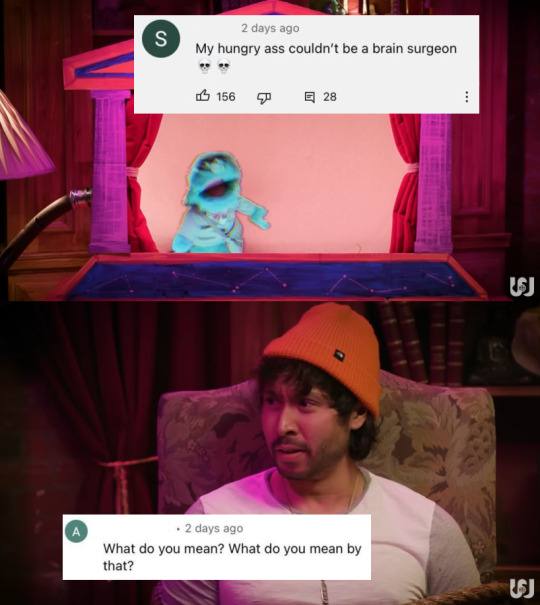
fucked up and widdle
#puppet history#ryan bergara#the professor#the substitute#the professor ph#Watcher#theres so much shit i wanna draw before the finale but i KNOW i wont be able to finish it bc ones like a 6 page comic ;__; hep me#greatest hits
9K notes
·
View notes
Text

Project Gunita on Twitter @ProjectGunitaPH:
LOOK: Ito ang boses ni Butz Aquino ng August Twenty-One Movement (ATOM) sa Radio Veritas noong gabi ng Pebrero 22, 1986 na nananawagan sa taumbayan na tumungo sa EDSA at magbarikada sa harap ng Camp Aguinaldo.
Source: "EDSA 1986: Mga Tinig ng Himagsikan." ABS-CBN, 2006.
#EDSA38 #DefendHistoricalTruth #BuhayAngEDSA
2024 Feb. 22
2 notes
·
View notes
Text
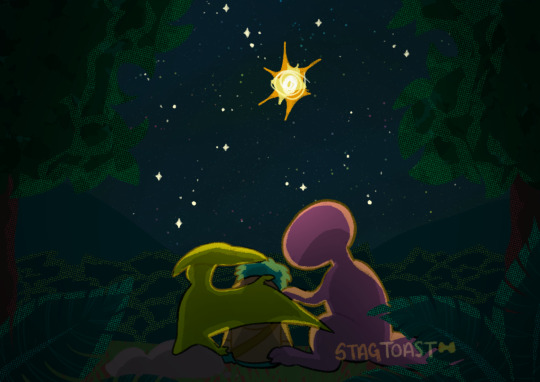
"hey, it's alright. you can't stop what's coming."
#watcher entertainment#watcher#puppet history fanart#the professor#puppet history#fanart#professor mcnasty#my art#puppet history spoilers#another wonderful episode of puppet history from watcher AND very exciting regarding the future of PH#is he gonna cohost with his parents ... are they gonna go on a cruise ... i must know
6K notes
·
View notes